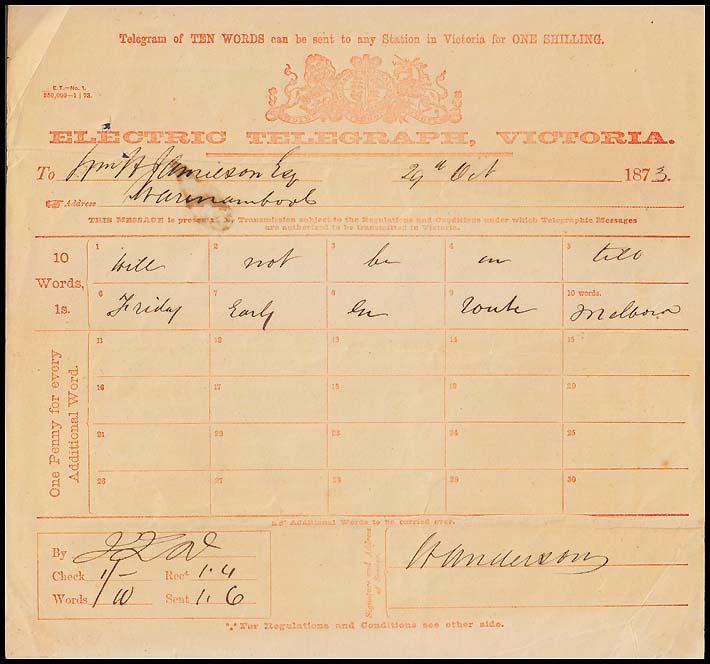Transmission form: VC-TO-5.
- Home, index, site details
- Australia 1901-1988
- New South Wales
- Queensland
- South Australia
- Tasmania
- Victoria
- Western Australia
- International
- Special aspects
| Heading and notes: | Form number E.T. No. 1. ELECTRIC TELEGRAPH, VICTORIA beneath crest. |
| Message area: | 30 boxes in 6 lines. First 10 words indicated. |
| Reverse side: | Regulations and conditions. |
| Colours (text & form): | Red on white which has discoloured. |
| Size of form overall: | 216 × 229 mm. |
- first Victorian form to have a form number E.T. No. 1 (top left);
- cost for 10 words written above Crest;
- space for first 10 words shown clearly from space for next 20 words.
A form with a new format was issued in July 1870. The Hobart Mercury of 23 July 1870 (p. 3) reported the features of this form as follows:
"The new telegraph forms, exact copies of those recently adopted with such success in Great Britain, have, says the Age (in describing the British form) been issued by the post office authorities for the convenience of the public. Any change, however beneficial ultimately, at first is invariably perplexing, and provocative of some annoyance. This change in the form for the telegraphic messages is no exception to the general rule; but for all that it appears calculated when it is better understood than at present, to answer the purpose for which it is intended admirably.
The new forms are in size slightly larger than the old style ; the color red on a white ground, is however still retained. The peculiar feature of the form is in a very simple arrangement provided for checking the number of words in each message. After the date and address which heads the page, the rest of the slip is ruled into five perpendicular columns. Each of these again is intersected by six lines ruled across the page, cutting the whole page up into thirty small squares.
Against the first ten of these squares are written the words "ten words one shilling" and against the subsequent twenty squares there is printed "one penny for every additional word". It will thus be seen that any person wishing to send a message has only to write it on any one of these forms, setting down one word in each square, when he at once knows how much his message will cost by noticing how many squares the message occupies. At the foot of the page, there is the usual lines left vacant for the signature and address of the sender, so as to prevent the possibility of confusion in transmitting messages".
Two examples of this form are known with printing date in May 1872 and January 1873. Although, given the above report, it must be assumed that printing began in 1870 or 1871, no form has been recorded with a printing date earlier than 1872.
The format of this Victorian form is similar to that issued by Tasmania in 1870-71 (TC-TO-2) but further modified with positive effect for users.
 Printed in January 1873. |
VC-TO-5.
E.T. No. 1: To Warnambool (probably from Melbourne). Has a small "pointing hand" before Address in the heading.
Prestige Philately had an example of the May 1872 printing in their August 2014 Sale in Lot 352. |
Details of use and rarity.
| Form sub-number |
Schedule number | Earliest recorded date | Rarity rating |
| TO-5 | 500,000 - 5/72 | Used form has no date. | RRR |
| 250,000 - 1/73. | 18 October 1873 at Belfast. | RRR |